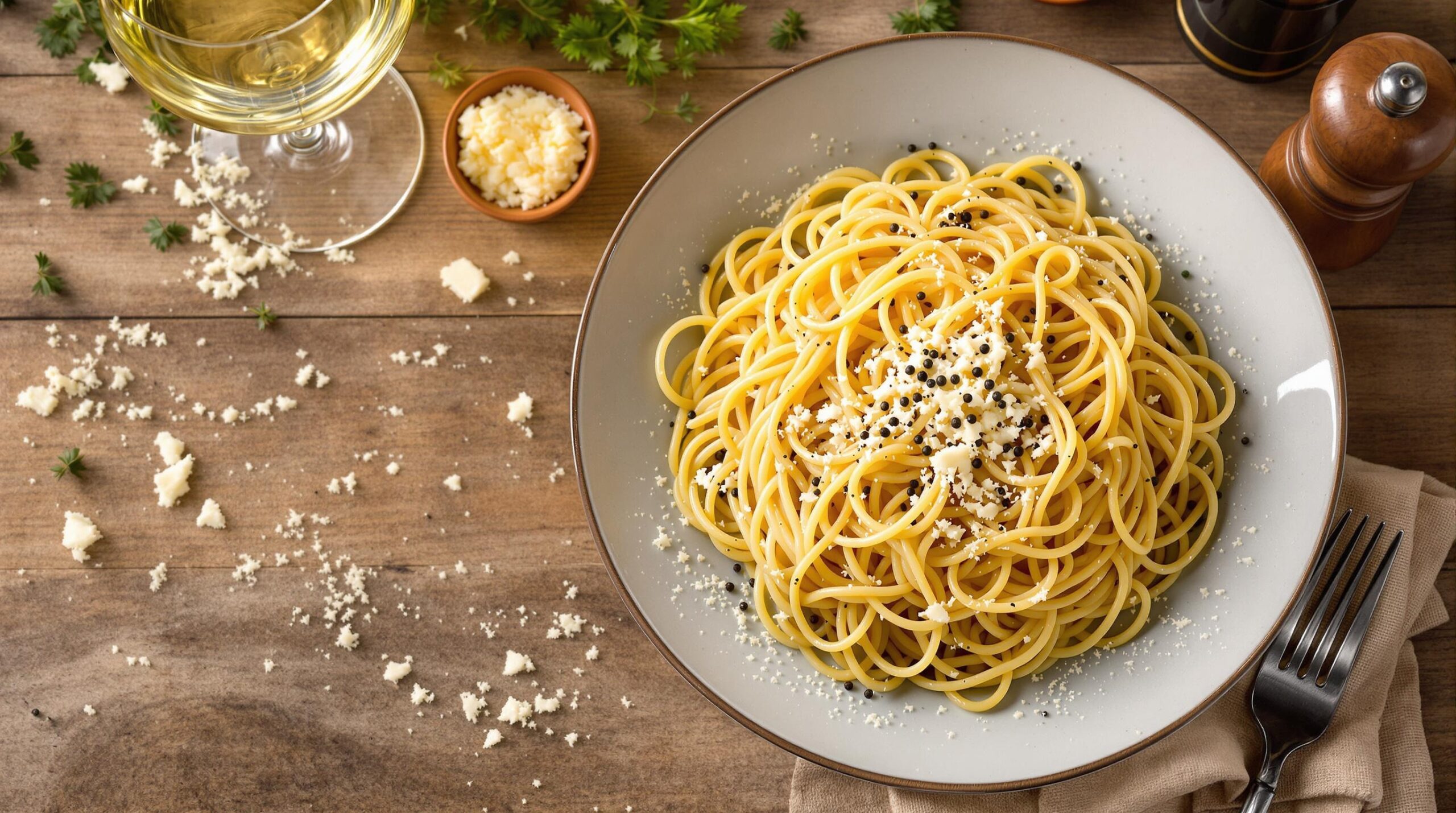Cacio e Pepe, a traditional Roman dish, exemplifies simplicity and flavor. The name translates to “cheese and pepper.” This combination of Pecorino Romano cheese and black pepper creates a comforting, timeless dish. Despite its simplicity, mastering Cacio e Pepe demands precision and care.
The Origins of Cacio e Pepe
Cacio e Pepe originated in Central Italy, particularly in the region of Lazio. Roman shepherds relied on these ingredients during pastoral journeys. With its long shelf-life, Pecorino Romano was a staple for these journeys. Black pepper provided heat and stimulating flavor, essential for the shepherds’ monotonous diet.
Today, Italian eateries worldwide serve Cacio e Pepe, celebrating its rustic roots. This dish’s enduring appeal lies in its rich history and wholesome ingredients. Enjoying Cacio e Pepe brings a taste of Italy’s pastoral tradition into today’s kitchens.
Key Ingredients and Their Roles
Cacio e Pepe employs three main ingredients: pasta, Pecorino Romano, and black pepper. The type of pasta matters significantly. Traditionally, tonnarelli or spaghetti are used because they hold the sauce well. Pasta serves as the vessel for the luxurious sauce in every forkful.
Pecorino Romano cheese adds to the dish’s distinctive tang. Aged between eight and twelve months, it yields robust flavor. High-quality cheese is crucial, so freshly grated is best for maximum flavor impact. Freshly cracked black pepper delivers a piquant contrast, enhancing Cacio e Pepe’s appeal. Avoid pre-ground pepper to preserve the dish’s vibrant flavor.
Crafting the Perfect Sauce
Creating the perfect Cacio e Pepe requires a careful process. While it may seem straightforward, achieving the right texture is an art. Begin by boiling the pasta in well-salted water. The traditional recipe uses only enough water to cover the pasta, creating a starchy cooking liquid essential for the sauce’s success.
Simultaneously, toast freshly cracked black pepper in a dry pan over medium heat. This action releases its essential oils, enhancing flavor. Once the pasta reaches al dente perfection, reserve some cooking water before draining it. The starchy water plays a crucial role in forming the sauce.
Add reserved pasta water to toasted black pepper, creating a peppery broth. This broth forms the base of the sauce. Off the heat, gradually incorporate Pecorino Romano using a circular whisking motion. The key is to avoid clumping, aiming for a smooth, creamy texture. Add pasta water incrementally if the sauce becomes too thick.
Balancing Flavor and Texture
Achieving the right balance of flavor and texture in Cacio e Pepe is key. The starch from the pasta water creates emulsification, resulting in a cohesive sauce. Balance is essential; the sauce should coat each strand of pasta without being soupy or dry. This balance reflects careful ingredient management.
Precision with cheese and pasta water helps ensure a silkiness interwoven with concentrated flavors. Equally, the interplay of cheese’s saltiness and pepper’s heat drives the dish’s complexity. Each forkful should offer a savory experience, awakening the palate with peppery warmth.
Perfecting the Dish in Your Kitchen
Cacio e Pepe welcomes variations, including added fats like butter or olive oil. Traditionalists often debate these inclusions’ merit, preferring the pure cheese and pepper profile. However, unsalted butter can enhance the sauce’s creaminess without overpowering core flavors.
Certain additions can elevate the dish further. A hint of lemon zest introduces brightness, while nutmeg offers warmth. Ultimately, maintaining Cacio e Pepe’s integrity involves subtlety in variation. Respecting its traditional flavors delivers authentic immersion into Italian cuisine.
Using the right tools dramatically affects your success. Opt for a microplane or grater to achieve a fine cheese texture. This ensures even melting, which prevents clumps in the sauce. A wooden spoon helps evenly distribute the cheese and pepper during tossing.
Serving Suggestions and Pairings
Cacio e Pepe’s simplicity makes it a versatile dish for pairing. It thrives as a stand-alone dish or a side in a multi-course menu. To complement Cacio e Pepe, consider a crisp white wine such as Verdicchio or Frascati. These wines’ acidity cuts through the richness, cleansing the palate.
A simple green salad with a light vinaigrette balances the meal with freshness and crunch. Avoid overly-powerful dressings, which may overshadow Cacio e Pepe’s subtlety. Alternatively, roasted vegetables can provide contrasting textures and flavors.
Bread may be an accompaniment, ideal for mopping up any remaining sauce. A rustic sourdough or traditional Italian pane complements the pasta’s heartiness. Such sides offer gentle contrast, enhancing the appreciation of the flavors on the plate.
Common Mistakes and Troubleshooting
Although straightforward, common errors can affect the outcome of Cacio e Pepe. Overcooking pasta is one such error, resulting in a loss of structure and texture. For the best results, aim for al dente.
Clumping cheese poses another challenge. Not letting the pasta cool or using overly hot water can cause this issue. Timing is everything; toss cheese when the mixture is warm but not hot. If clumps occur, adding more pasta water can enhance emulsification.
Some find the sauce lacking in creaminess due to improper emulsification. To maintain a smooth sauce, avoid adding too much cheese before integrating enough water. Progress gradually, adjusting ingredients as needed.
Final Thoughts on Mastering Cacio e Pepe
Mastering Cacio e Pepe enriches your culinary repertoire, offering authentic taste with minimal ingredients. Despite the dish’s simplicity, it reflects Italian culinary principles of precision and quality ingredients. Traditional preparation respects these roots while welcoming contemporary adaptations.
Cacio e Pepe invites cooks to indulge in culinary exploration. By focusing on technique, you can bridge tradition with modern culinary art. Sharing this dish connects diners with the essence of Italian culture, blending heritage and everyday delight.
The pursuit of culinary refinement meets satisfaction in savoring Cacio e Pepe. Each attempt enhances understanding, creating delicious outcomes and meaningful connections to Italy’s rich history. With care and practice, anyone can accomplish the perfect bowl of Cacio e Pepe.
Crafting Cacio e Pepe is a journey of technique, patience, and respect for tradition. By utilizing these straightforward steps and tips, anyone can master this timeless dish.


